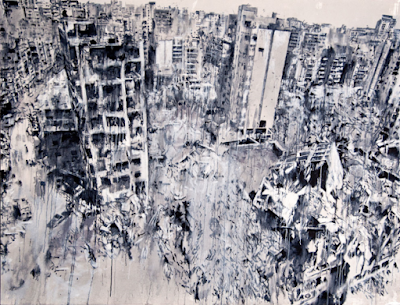Friday, 27 April 2018
Powerful images from land of conflict and devastation by Syrian artist Tammam Azzam.
The Syrian war, as we all know too well, has been one of the bloodiest of the 21st century. It has bred the biggest refugee crisis since World War II, and the ever climbing death toll, sees no signs of abating. Despite this Syrian artists have managed to render their pain, and create art and to bear witness with artistic memory to this nation torn apart, conveying their hope and despair for the world to see.
The above picture depicting a Statue of Liberty-like structure,rising from the ruins of Syria has recently been doing the rounds of the internet. The image in question is from a work by Syrian Artist, Tammam Azzam, and is actually a digital composition in which different parts of bombed out buildings are assembled together to resemble French sculptor Frédéric Auguste Bartholdi’s statue.The artist has been in the spotlight previously for addressing the Syrian tragedy through his work ( when he photoshoped in 2013 Klimt’s “The Kiss” atop a war-ravaged building from Syria). It is one of many pieces created by the artist over the course of this long running conflict.
Another haunting picture of his shows a Syrian building floating on balloons out of the smoking hole in the side of the Twin Towers on 9/11.
One other shows a hand grenade made of brightly coloured flowers which Azzam captioned "Syrian Spring "
Tammam Azzam
Born in Damascus, Syria in 1980, Tammam Azzam received his artistic training from the Faculty of Fine Arts, University of Damascus with a concentration in oil painting. Alongside a successful career as a painter in Syria, Azzam was a prolific graphic designer. Forced to flee from his home and studio in Damascus at the start of the Syrian civil war in 2011, Tammam Azzam left behind his painting materials and reputation as one of Syria’s key artists. Restless in his exile, Azzam could only watch the developments of the conflict stream through his Twitter feed, increasing in number and devastation every day. Anguished in his powerlessness, he could no longer withstand the despair such destruction caused him. As a substitute for paintbrush and canvas, Azzam adapted to a new medium: digital art in which to express himself and his sadness with the events that were unfolding in his homeland of Syria.
Henri Matisse, The Dance (1910)
The artist who is not affiliated with or embedded in any opposition group, moved to Dubai where he spent the next four years. Here in a solo exhibition held in November 2012 in Ayyam Gallery Dubai (Al Quoz), digital artworks representing a location the Syrian Uprising has affected were overlaid with the text, ‘In the revolution’, followed by the name of the area that witnessed the revolution. Other examples took the form of fractured and wounded maps of my country, stop signs covered with bullet holes, bleeding apples, fallen chess pawns and puzzle pieces, and symbols of peace reconfigured into targets, all symbolizing the violence and suffering the Syrians are facing.
Azzam who is still an active Twitter user, takes advantage of his international fame to share updates of the conflict, but he mainly spreads messages of peace. The artist tweeted an article about the statue of Liberty image to clarify his position and the misleading associations that have been attached to it.
Whether made digitally or photoshopped his work remain powerful pieces of art, and through his eyes,as he sees it expresses a need for unity and the fact that human suffering is the same whatever part of this planet we are on. He remains an arresting visual chronicler of what remains when an entire people’s way of life is upended, possibly for generations to come, using the means available to him, to show the world what is going on in his country and reinforce that “empathy should not be limited to the first world”.My heart personally goes out to all those currently suffering the devastating impact of war.
Azzam currently lives and works in Deimenhorst, Germany and has contributed to large scale international exhibitions across the world.
https://twitter.com/tammamazzam
Subscribe to:
Post Comments (Atom)







No comments:
Post a Comment